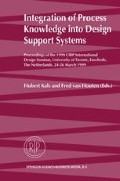Abstract
Effectiveness and quality of the output of designing is strongly influenced by the in-process decisions made by designers. In order to support decision making by using computers, the mechanisms of design thinking and reasoning have to be understood and modeled. This paper proposes an advanced Petri-net as an appropriate tool for modeling design processes together with the decision patterns of designers. It has been developed based on practical observations of design processes. The novel interpretation of tokens and the set of enhanced transition entities support simulation of procedural and contextual decisions.
Access this chapter
Tax calculation will be finalised at checkout
Purchases are for personal use only
Preview
Unable to display preview. Download preview PDF.
References
D’Souza, K. A., Khator, S. K.: “A Survey of Petri Net Applications in Modeling Controls for Automated Manufacturing systems”, Computers in Industry, Vol. 24, 1994, pp. 5–16.
Devapriya, D. S., Descotes-Genon, B., Ladet, P.: “Petri Net Based Node Structures for Distributed Problem Solving in FMS Control”, Computer Integrated Manufacturing Systems, Vol. 5, No. 3, 1992, pp. 229–238.
Kusiak, A., Wang, J.: “Efficient Organizing of Design Activities”, International Journal of Production Research, Vol. 31, No. 4, 1993, pp. 753–769.
McMahon, C. A., Xianyi, M.: “A Network Approach to Parametric Design Integration”, Research in Engineering Design, Vol. 8, 1996, pp. 14–32.
Murata, T.: “Petri Nets: Properties, Analysis and Applications”, Proceedings of the IEEE, Vol. 77, No. 4, 1989, pp. 541–580.
Stauffer, L. A.: “An Empirical Study on the Process of Mechanical Design”, Ph.D. thesis, Department of Mechanical Engineering, Oregon State University, Corvallis, OR, USA, 1987.
Ullman, D. G., Dietterich, T. G., Stauffer, L. A. “A Model of the Mechanical Design Process Based on Empirical Data”, AI EDAM, Vol. 2, No. 1, 1988, pp. 33–52.
Author information
Authors and Affiliations
Editor information
Editors and Affiliations
Rights and permissions
Copyright information
© 1999 Springer Science+Business Media Dordrecht
About this paper
Cite this paper
Horváth, I., Vergeest, J.S.M., Knoop, W.G. (1999). Using advanced Petri-net for representation of decisions in the design process. In: Kals, H., van Houten, F. (eds) Integration of Process Knowledge into Design Support Systems. Springer, Dordrecht. https://doi.org/10.1007/978-94-017-1901-8_11
Download citation
DOI: https://doi.org/10.1007/978-94-017-1901-8_11
Publisher Name: Springer, Dordrecht
Print ISBN: 978-90-481-5199-8
Online ISBN: 978-94-017-1901-8
eBook Packages: Springer Book Archive

